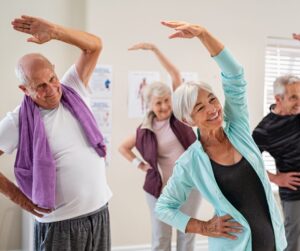Dancing is an incredible form of artistic expression and a fun way to stay active. Whether you’re a beginner or an experienced dancer, the joy of moving to the rhythm comes with certain risks. Dance injuries are quite common, and although they can happen to anyone, the good news is that most of them can be prevented with the right knowledge and techniques. In this post, we’ll explore the five most common dance injuries, how they occur, and practical steps to prevent them, helping dancers at Fred Astaire Dance Studio of Glenn Heights stay safe and injury-free.
1. Sprained Ankles
One of the most common dance injuries is a sprained ankle. It often happens when dancers twist or turn their ankle awkwardly, causing strain or damage to the ligaments.
How to Prevent It:
- Warm-Up and Stretch: Always take time to properly warm up before dancing. Focus on ankle flexibility and mobility exercises to prepare the joints for intense movement.
- Wear Proper Footwear: Dance shoes that fit well and offer good support can help reduce the risk of ankle injuries. Be sure that your shoes are specific to your dance style.
- Strengthen Your Ankles: Regular ankle-strengthening exercises, such as resistance band exercises or calf raises, will help stabilize the joint and prevent strains.
2. Knee Injuries
Knee injuries are another common issue, especially in dancers who perform frequent turns, leaps, and rapid direction changes. The knee is vulnerable to overuse and improper technique, leading to issues like patellar tendinitis or torn ligaments.
How to Prevent It:
- Focus on Alignment: Pay attention to your body alignment while dancing. Proper knee alignment—keeping your knees in line with your toes—helps prevent unnecessary stress on the joint.
- Cross-Training: Engage in low-impact activities like swimming or cycling to keep the muscles surrounding the knee strong without overloading the joint.
- Use Supportive Gear: For those recovering from a knee injury, wearing knee supports or braces during practice can provide extra stability and protection.
3. Lower Back Pain
Lower back pain is a frequent complaint among dancers. Overuse, poor posture, or improper lifting techniques can contribute to stress on the spine, leading to chronic discomfort or injury.
How to Prevent It:
- Strengthen Your Core: A strong core is key to protecting your lower back. Incorporate exercises that focus on your abdominal and lower back muscles, such as planks and bridges, into your training routine.
- Maintain Proper Posture: Always focus on keeping your spine in a neutral position while dancing. Avoid arching your back too much or slouching, which can strain the lower back.
- Practice Flexibility: Stretching regularly helps keep the muscles and ligaments around the lower back flexible. Try incorporating yoga poses that emphasize spinal mobility.
4. Hamstring Strains
Hamstring strains are another prevalent injury among dancers, especially those who perform high kicks, splits, or deep lunges. These injuries occur when the hamstring muscles (the muscles at the back of the thigh) are overstretched or pulled during a movement.
How to Prevent It:
- Proper Warm-Up: Warm up your entire body with dynamic stretches before you start dancing. Focus particularly on the hamstrings by performing leg swings and lunges to increase flexibility.
- Avoid Overstretching: Pushing your body beyond its limits can lead to strains. Gradually increase the intensity of your stretches and dance movements to allow your muscles to adapt.
- Strengthen Hamstrings: Strengthen your hamstrings with exercises like leg curls, deadlifts, or bridge lifts. This helps the muscles become more resilient to injury.
5. Stress Fractures
Stress fractures, particularly in the feet and lower legs, can occur over time with repeated impact during activities such as jumping or landing. These microfractures typically develop in the bones due to excessive pressure and can cause significant pain if not addressed.
How to Prevent It:
- Rest and Recovery: Give your body enough time to rest between intense training sessions. Overtraining is one of the leading causes of stress fractures, so it’s essential to allow your muscles and bones to recover.
- Footwear Matters: Choose dance shoes that provide adequate cushioning and support. For ballet dancers, wearing padded insoles can help absorb impact from jumps and landings.
- Cross-Train: Diversifying your exercise routine can help reduce the repetitive impact on your feet and lower legs. Swimming, cycling, or Pilates can help you maintain fitness while reducing the risk of stress fractures.

General Tips for Dance Safety
In addition to preventing these specific injuries, there are a few universal tips every dancer should follow to ensure long-term safety:
- Listen to Your Body: If something doesn’t feel right, don’t push through the pain. Take a break and consult a professional if needed. Injuries can worsen if ignored.
- Stay Hydrated and Nourished: Proper hydration and nutrition support muscle recovery and joint function. Drink plenty of water and fuel your body with nutrient-rich foods.
- Regularly Stretch and Cool Down: A good cool-down session after practice is just as important as warming up. Stretching your muscles afterward helps maintain flexibility and reduce the risk of injury.
- Consult Your Instructor: At Fred Astaire Dance Studio of Glenn Heights, our instructors are trained to provide guidance on proper technique. Don’t hesitate to ask for feedback to ensure you’re practicing safely.
Dancing is a wonderful and rewarding activity, but like any physical activity, it carries the risk of injury. By understanding the common dance injuries and adopting preventative measures, you can minimize the chances of getting hurt and enjoy a long, successful dance journey. At Fred Astaire Dance Studio of Glenn Heights, we emphasize dance safety, ensuring that every dancer has the tools and knowledge they need to stay safe while improving their technique. Stay proactive, stay informed, and most importantly, keep dancing!
Discover the thrill of dancing! Reach out to Fred Astaire Dance Studio of Glenn Heights now at (520) 300-5490, or visit our website to learn about our classes, upcoming events, and special introductory offers.

